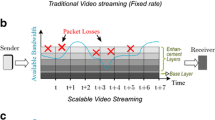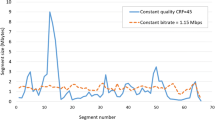Abstract
Video streaming over Internet has been gaining momentum and several quality adaptation schemes have been reported to improve quality of the streamed videos. Most of these schemes focus on adjusting the video encoding rate to match certain network conditions. This paper presents a new quality adaptation algorithm for real-time video streaming over Internet. The proposed algorithm is based upon simultaneous adaptation of multiple key parameters such as video frame rate, resolution, and frame quality to achieve the best possible video quality and minimize possibility of service interruption in lossy networks. Furthermore, the current network status and motion of the streamed video sequence have also been taken into account throughout the adaptation process. A video conferencing test-bed which incorporates the Adobe Flash Real-Time Media Flow Protocol (RTMFP) is built and utilized to investigate the effect of various combinations of the video parameters under study on the quality of sample video clips streamed at slow, medium and fast motions. A quality-adaptation algorithm based on experimental investigations is then developed and its performance is assessed using both subjective and objective evaluations. The obtained results and observations demonstrate superior performance of the developed adaptation algorithm as compared to equivalent algorithms with fixed video quality settings at similar test conditions.









Similar content being viewed by others
References
Annadurai S, Shanmugalakshmi R (2007) Fundamental of digital image processing. Pearson Education, India
Arregoces M, Portolani M (2003) Data center fundamentals. Cisco Press, USA
Baset SA, Schulzrinne HG (2006) An Analysis of the skype peer-to-peer internet telephony protocol. Proceedings INFOCOM 25th IEEE International Conference on Computer Communications. doi:10.1109/INFOCOM.2006.312
Braun R (1997) Internet protocols for multimedia communications. I. IPng-the foundation of Internet protocols. IEEE Trans Multimedia 4:85–90. doi:10.1109/93.621586
Chan A, Zeng K, Mohapatra P, Lee SJ, Banerjee S (2010) Metrics for evaluating video streaming quality in lossy IEEE 802.11 wireless networks. Proceedings IEEE INFOCOM. doi:10.1109/INFCOM.2010.5461979
Ciavattone L, Morton A, Ramachandran G (2003) Standardized active measurements on a tier 1 IP backbone. IEEE Commun Mag 41:90–97. doi:10.1109/MCOM.2003.1204753
Hadar O, Shmueli R, Huber R (2004) Effects of frame rate, frame size and MPEG-2 compression on the perceived compressed video quality transmitted over lossy IP networks. Proc. 2nd Int. Conf. on Information Technology: Research and Education, London, England. doi:10.1109/ITRE.2004.1393644
Hsu CY, Ortega A, Khansari M (1999) Rate control for robust video transmission over burst-error wireless channels. IEEE J Sel Areas Commun 17:756–773. doi:10.1109/49.768193
http://compression.ru/video/quality_measure/video_measurement_tool_en.html. Accessed 20 Oct 2016
http://www.adobe.com/devnet/adobe-media-server/articles/real-time-collaboration.html. Accessed 20 Oct 2016
http://www.adobe.com/products/adobe-media-server-family.html. Accessed 20 Oct 2016
Huynh-Thu Q, Ghanbari M (2012) The accuracy of PSNR in predicting video quality for different video scenes and frame rates. Telecommun Syst 49:35–48. doi:10.1007/s11235-010-9351-x
ITU-R Recommendation BT.500-11 (2002) Methodology for the subjective assessment of the quality of television pictures. International Telecommunication Union, Geneva
ITU-T Recommendations, P.910 (1999) Subjective video quality assessment methods for multimedia applications. International Telecommunication Union, Geneva
Jammeh E, Mkwawa I, Khan A, Goudarzi M, Sun L, Ifeachor E (2012) Quality of experience (QoE) driven adaptation scheme for voice/video over IP. Telecommun Syst 49:99–111. doi:10.1007/s11235-010-9356-5
Joonho C, Reaz A, Mukherjee B (2012) A survey of user behavior in VoD service and bandwidth-saving multicast streaming schemes. IEEE Commun Surv Tutorials 14:156–169. doi:10.1109/SURV.2011.030811.00051
Khalifeh A, Yousefi’zadeh H (2010) Optimal audio transmission over error-prone wireless links. IEEE Trans Multimedia 12:204–214. doi:10.1109/TMM.2010.2041096
Khan A, Sun L, Ifeachor E (2009) Content-based video quality prediction for MPEG4 video streaming over wireless networks. J Multimed 4:228–239. doi:10.1109/ICC.2009.5198850
Koul M (2008) Analysis of the effects of packet loss and delay jitter on MPEG-4 video quality, Technical report. Electrical Engineering Department, The University of Texas at Arlington, Arlington
ManyCam Virtual Webcam software website, available at http://www.manycam.com. Accessed 20 Oct 2016
MS Network Emulator. Available at: http://blog.mrpol.nl/2010/01/14/network-emulator-toolkit. Accessed 20 Oct 2016
Murshed A, Khalifeh A, Al-Taee M (2013) Quality of experience analysis of video transmission over lossy networks. Proc. IEEE Applied Electrical Engineering and Computing Technologies (AEECT), Amman-Jordan, December 3–5, 2013
Nejati N, Yousefi’zadeh H, Jafarkhani H (2010) Distortion optimal transmission of multi-layered FGS video over wireless channels. IEEE J Sel Areas Commun (JSAC) Spec Issue Wireless Video Transm 28:510–519. doi:10.1109/JSAC.2010.100421
Ortega A, Ramchandran K (1998) Rate-distortion methods for image and video compression. IEEE Signal Process Mag 15:23–50. doi:10.1109/79.733495
Pappas TN, Safranek RJ (2000) Perceptual criteria for image quality evaluation. Handbook of image and video processing, pp 669–684
Seshadrinathan K, Soundararajan R, Bovik AC, Cormack LK (2010) Study of subjective and objective quality assessment of video image. IEEE Trans Image Process 19:1427–1441. doi:10.1109/JSTSP.2012.2212417
Shmueli R, Hadar O, Huber R, Maltz M, Huber M (2008) Effects of an encoding scheme on perceived video quality transmitted over lossy Internet protocol networks. IEEE Trans Broadcast 54:628–640. doi:10.1109/TBC.2008.2001242
Singh K, Davids C (2011) Flash-based audio and video communication in the cloud. Arxiv preprint arXiv:1107.0011
Sudarshan S, Banaei-Kashani F, Shahabi C (2013) Real-time video segmentation based on motion detection. Integrated Media System Center Retreat (IMSC)
Sullivan GJ, Wiegand T (1998) Rate-distortion optimization for video compression. IEEE Signal Process Mag 15:74–90. doi:10.1109/79.733497
Test video sequences. https://media.xiph.org/video/derf/. Accessed 20 Oct 2016
Trestian R, Ormond O, Muntean G-M (2013) Energy–quality–cost tradeoff in a multimedia-based heterogeneous wireless network environment. IEEE Trans Broadcast 59:340–357. doi:10.1109/TBC.2013.2244790
Uti V, Fox R (2009) Improving delivery rate for real time mobile streaming video. Proc. 21st IEEE International Conference on Tools with Artificial Intelligence. doi:10.1109/ICTAI.2009.34
Venkataraman M, Chatterjee M, Chattopadhyay S (2009) Evaluating quality of experience for streaming video in real time. Global Telecommunications Conference, GLOBECOM IEEE. doi:10.1109/GLOCOM.2009.5425806
Wu H, Claypool M, Kinicki RE (2006) Guidelines for selecting practical MPEG group of pictures. In: Proceeding of: Proceedings of the IASTED International Conference on Internet and Multimedia Systems and Applications, Innsbruck, Austria
Acknowledgments
The authors would like to thank the Jordanian Scientific Research Fund (grant no. ICT/1/04/2014) for funding this project throughout the different phases of its development lifecycle.
Author information
Authors and Affiliations
Corresponding author
Appendices
Appendix 1
Appendix 2
Rights and permissions
About this article
Cite this article
Khalifeh, A.F., Al-Taee, M.A. & Murshed, A.N. Network-status aware quality adaptation algorithm for improving real-time video streaming over the internet. Multimed Tools Appl 76, 26129–26152 (2017). https://doi.org/10.1007/s11042-016-3999-5
Received:
Revised:
Accepted:
Published:
Issue Date:
DOI: https://doi.org/10.1007/s11042-016-3999-5





